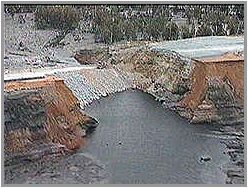| Impacts of Mining | |
|
Direct impact of the mine Many mines are at the surface (sometimes called open cast mines). They may consist of a great hole in the ground (most copper mines), strip mining along the tops of ridges (nickel in New Caledonia), the digging out of ore in pits and sheets across a large surface (phosphates), or a pit or hillside excavation (rock and sand quarries). With such mines, the land surface over a considerable area is destroyed, and what is left behind may be unstable, producing landslides, erosion, siltation, and polluted water. Such land is generally useless after the mining ends, and may continue to cause environmental problems long after the mine has closed. When the mine is beneath the surface and is composed of tunnels, the disturbance is usually localised at the mine entrance unless there are later cave-ins or some interference with ground-water supplies. The drilling of oil wells may cause some local environmental effects from the machinery and drilling muds used, and there is a slight risk of blow-outs or accidental breakage leading to oil spillage, but once the well is in operation, there is generally little further effect. Any kind of mine may cause some water pollution through water drained or pumped from the mine. Disposal of mine wastes In most mining operations, a great deal of waste rock and tailings must be moved to reach the ore. In addition to rock covering the ore or mixed in with the ore, there may be low grade ores that are not worth treating. The disposal of these wastes from the mine often causes more environmental damage than the mine itself. The problems come both from the enormous quantities of rock to be disposed of, and the fact that some mine wastes may be toxic to plants or cause water pollution as water drains through them. The dumping of these wastes may affect more land surface than the mine. Waste dumps are subject to erosion, and are difficult to stabilise or re-vegetate. It is sometimes even necessary to build dams to hold the wastes back. Inadequately contained mine wastes have damaged or destroyed rivers and agricultural land and caused heavy flooding (See picture). In some mines the wastes are intentionally washed in to a river so that they will be carried away to the sea, with severe effects on the river, its valley, and the sea coast at the river mouth. |
|
|
Transport of ores Mines are usually located in remote areas, requiring the transport of the mineral in some form from the mine to a port where it can be shipped to its markets. The infrastructure for the transport of large quantities of heavy material may involve roads, railroads, pipelines and conveyor belts, the construction and operation of which may have considerable environmental impacts, particularly since the terrain crossed is often difficult. Major port facilities and storage areas are also generally required. |
 Tailings dam, Los Frailes, Goldmine, Southern Spain |
|
Ore treatment or refining Since transportation cost in island regions are very high, and are related to the bulk of the material, there is a strong incentive for at least some treatment of the ore to concentrate it if not refine it completely. This generally requires large industrial installations and the further production of wastes to be disposed of. Furthermore, ore treatment often requires chemicals like mercury or cyanide (used in gold mining), or strong acids or alkalis, and the metals being treated may themselves be toxic. Some accumulate in food chains, threatening human food supplies. Even if the wastes are treated, there usually is some spillage, and there is always the risk of accidents. |
|